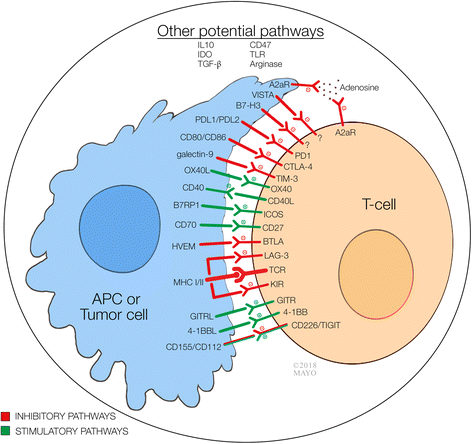Next generation of immune checkpoint therapy in cancer: new developments and challenges
- PMID: 29544515
- PMCID: PMC5856308
- DOI: 10.1186/s13045-018-0582-8
Next generation of immune checkpoint therapy in cancer: new developments and challenges
Abstract
Immune checkpoints consist of inhibitory and stimulatory pathways that maintain self-tolerance and assist with immune response. In cancer, immune checkpoint pathways are often activated to inhibit the nascent anti-tumor immune response. Immune checkpoint therapies act by blocking or stimulating these pathways and enhance the body's immunological activity against tumors. Cytotoxic T lymphocyte-associated molecule-4 (CTLA-4), programmed cell death receptor-1 (PD-1), and programmed cell death ligand-1(PD-L1) are the most widely studied and recognized inhibitory checkpoint pathways. Drugs blocking these pathways are currently utilized for a wide variety of malignancies and have demonstrated durable clinical activities in a subset of cancer patients. This approach is rapidly extending beyond CTLA-4 and PD-1/PD-L1. New inhibitory pathways are under investigation, and drugs blocking LAG-3, TIM-3, TIGIT, VISTA, or B7/H3 are being investigated. Furthermore, agonists of stimulatory checkpoint pathways such as OX40, ICOS, GITR, 4-1BB, CD40, or molecules targeting tumor microenvironment components like IDO or TLR are under investigation. In this article, we have provided a comprehensive review of immune checkpoint pathways involved in cancer immunotherapy, and discuss their mechanisms and the therapeutic interventions currently under investigation in phase I/II clinical trials. We also reviewed the limitations, toxicities, and challenges and outline the possible future research directions.
Keywords: Cancer; Co-stimulatory pathways; Cytotoxic T lymphocytes; Immune checkpoint therapy; Immune evasion; Immunotherapy; Inhibitory pathways; Tumor microenvironment.
Conflict of interest statement
Ethics approval and consent to participate
Not applicable.
Consent for publication
Not applicable.
Competing interests
The authors declare that they have no competing interests.
Publisher’s Note
Springer Nature remains neutral with regard to jurisdictional claims in published maps and institutional affiliations.
Figures
References
Publication types
MeSH terms
Substances
LinkOut - more resources
Full Text Sources
Other Literature Sources
Research Materials


